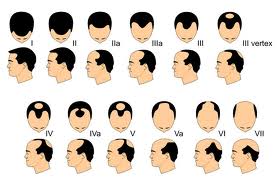

Hereditary hair loss affecting males and females
Androgenic alopecia, otherwise known as male baldness, is the most frequent type of hair loss. It is a special type of alopecia with presumed specific sensitivity of hair follicles to circulating androgens. In the hair follicle there are two important enzymes: aromatase and 5α reductase. When testosterone arrives to a hair follicle cell, it reacts with an androgenic receptor and forms an activated complex. DNA content decreases as well as the amount of mitoses in follicle matrix cells. Gradually the follicle matrix and dermal papilla are reduced and therefore the follicle progressively shrinks. The miniaturised follicle produces even thinner hair without medulla and pigment until the hair follicle gradually becomes extinct. Histologically , a sign of evolution is the presence of undetermined follicles of intermedial size, which are located among the follicles producing terminal hair and the follicles producing vellus hair. Androgenic alopecia occurs equally with males and females except for the one difference that females do not go completely bald while males do.

Each hair follicle has receptors that react to the presence of testosterone. What is it that some men have rich hair while some have only feathers? The reason why some men have a greater tendency towards hair fallout and others don’t is dye to a genetically established number of receptors in the follicle cell structure. Reduction of testosterone causes formation of dihydrotestorene (DHT), which, to a greater extent, connects to cell structures and interferes with their energy metabolism. Hair bulbs get weaker and gradually become extinct, which results in hair fallout. To prevent hair fallout it is beneficial to use products containing substances that congest hair follicles and counteract androgens. Cutting hair does not increase hair density because it does not have any impact on the activity of follicles. We are born with a certain number of hair follicles – from 100 to 150 thousand – and in the course of life new follicles do not form.
The occurrence of this illness can be largely attributed to heredity. If the symptoms of androgenic alopecia already appear before the age of 20, the development is very rapid. However, there are also individual differences. With the first occurrence in men over 30 years of age, the progress is mild and baldness does not develop completely; it remains only in the area of the forehead. The progress of alopecia may be worsened by associated illnesses of hair skin and long-term consumption of drugs administered for various illnesses.

